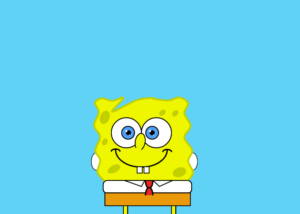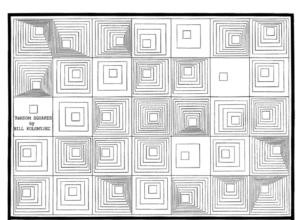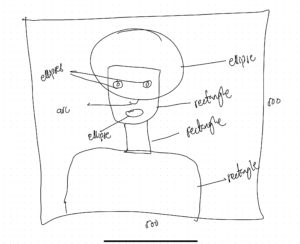Portrait of SpongeBob SquarePants
function setup() {
createCanvas(700, 500);
background(32, 210, 245);
angleMode(DEGREES);
}
function draw() {
strokeWeight(1);
//drawing points to get curve shape
point(244, 422);
point(228, 402);
point(234, 374);
point(223, 351);
point(234, 320);
point(220, 293);
point(231, 262);
point(222, 240);
point(238, 230);
point(262, 236);
point(288, 229);
point(320, 234);
point(358, 231);
//rightside curve
point(450, 402);
point(439, 376);
point(448, 351);
point(430, 321);
point(444, 294);
point(430, 265);
point(438, 241);
point(418, 228);
point(393, 235);
point(439, 421);
//creating hands
stroke(0);
fill(255, 255, 255);
ellipse(225, 377, 23, 40);
stroke(0);
fill(255, 255, 255);
ellipse(449, 377, 23, 40);
//creating curve from points
stroke(197, 207, 19);
strokeWeight(4);
fill(241, 245, 32);
beginShape();
curveVertex(244, 422);
curveVertex(244, 422);
curveVertex(228, 402);
curveVertex(234, 374);
curveVertex(223, 351);
curveVertex(234, 319);
curveVertex(220, 293);
curveVertex(231, 262);
curveVertex(222, 240);
curveVertex(238, 230);
curveVertex(262, 236);
curveVertex(288, 229);
curveVertex(262, 261);
curveVertex(320, 234);
curveVertex(358, 229);
curveVertex(358, 231);
curveVertex(393, 235);
curveVertex(418, 228);
curveVertex(438, 241);
curveVertex(430, 265);
curveVertex(444, 294);
curveVertex(430, 321);
curveVertex(448, 351);
curveVertex(439, 376);
curveVertex(450, 402);
curveVertex(439, 421);
curveVertex(439, 421);
endShape();
//drawing for eyes
stroke(0);
strokeWeight(2);
fill(255, 255, 255);
circle(365, 310, 70);
//2nd eyes
stroke(0);
strokeWeight(2);
fill(255, 255, 255);
circle(295, 310, 70);
//inner circless for eyes
stroke(0);
strokeWeight(2);
fill(32, 160, 245);
circle(299, 310, 30);
stroke(0);
strokeWeight(2);
fill(32, 160, 245);
circle(355, 310, 30);
//inner inner eyes
stroke(0);
strokeWeight(2);
fill(0);
circle(300, 310, 10);
stroke(0);
strokeWeight(2);
fill(0);
circle(355, 310, 10);
//white patches of cirlcles to make eyes realistic
//left eye
noStroke(0);
fill(255, 255, 255);
circle(295, 306, 5);
//lower circle
noStroke(0);
fill(255, 255, 255);
circle(302, 315, 2.5);
//for right eye
noStroke(0);
fill(255, 255, 255);
circle(350, 306, 5);
//lower circle
noStroke(0);
fill(255, 255, 255);
circle(358, 315, 2.5);
//lower rectangles
stroke(0);
fill(255, 255, 255);
rect(241, 421, 206, 30, 10);
fill(245, 153, 32);
rect(245, 450, 199, 30);
//smile on Bob's face
stroke(0);
strokeWeight(3);
fill(241, 245, 32);
arc(330, 350, 120, 80, 0, 180);
stroke(0);
strokeWeight(3);
noFill();
arc(270, 353, 20, 10, -180, 0);
arc(390, 354, 20, 10, -180, 0);
//red blushing of Bob
// stroke(245, 99, 32);
// strokeWeight(3);
// noFill(197, 207, 19);
// arc(270,345,50,35,-190,20)
// arc(390,345,50,35,-190,20)
//Bob's tie
stroke(0);
strokeWeight(2);
triangle(290, 421, 330, 435, 338, 421);
triangle(357, 421, 372, 435, 403, 421);
stroke(0);
strokeWeight(3);
fill(245, 39, 32);
arc(348, 422, 17, 35, 0, 180);
arc(348, 455, 17, 35, 180, 0);
// stroke(0);
// strokeWeight(1);
// strokeJoin(ROUND);
// triangle(338,421,349,443,357,421)
stroke(0);
strokeWeight(2);
fill(245, 245, 32);
rect(288,480,10,25);
rect(400,480,10,25)
stroke(0);
strokeWeight(2);
fill(255, 255, 255);
rect(320, 389, 12, 15);
rect(336, 389, 12, 15);
//ellipse for nose
translate(61, -60);
rotate(10);
stroke(0);
fill(241, 245, 32);
ellipse(330, 339, 23, 40);
translate(12, 1);
rotate(1);
noStroke();
fill(241, 245, 32);
rect(310, 348, 20, 20);
//other spots on body
translate(20, -60);
rotate(10);
stroke(197, 207, 19);
fill(197, 207, 19);
ellipse(270, 310, 20, 30);
translate(20, -60);
rotate(10);
stroke(197, 207, 19);
fill(197, 207, 19);
ellipse(340, 370, 10, 15);
translate(20, -60);
rotate(10);
stroke(197, 207, 19);
fill(197, 207, 19);
ellipse(470, 210, 10, 15);
translate(20, -60);
rotate(10);
stroke(197, 207, 19);
fill(197, 207, 19);
ellipse(470, 210, 10, 15);
translate(20, -60);
rotate(10);
stroke(197, 207, 19);
fill(197, 207, 19);
ellipse(550, 350, 15, 30);
translate(20, -60);
rotate(10);
stroke(197, 207, 19);
fill(197, 207, 19);
ellipse(650, 170, 20, 30);
// translate(20, -60);
// rotate(-60);
// stroke(0);
// strokeWeight(1)
// fill(245, 245, 32);
// rect(-82, 692, 9, 80);
print(mouseX + "," + mouseY);
}
Result:

Here




